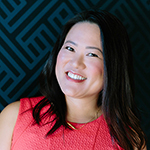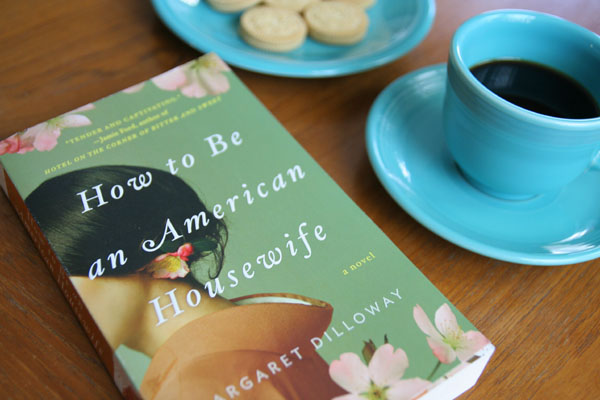Just how are you supposed to raise children, have a perfect home, and navigate cross-cultural differences? Beats me.
Imagine how much more difficult it was to be in an interracial marriage back in the 1950s.
Margaret Dilloway‘s debut novel follows the story of a Japanese woman, Shoko, who marries an American GI. Starting off in San Diego in the present day, the narrative dips back in time to Shoko’s childhood in Japan during the aftermath of World War II. Each chapter of How to be an American Housewife starts off with a “tip” from a fictional handbook of the same name, aimed at training Japanese brides how to acculturate to their new lives in the United States.
Japanese say “No” when they mean “Perhaps.” Therefore, if you are talking in English to an American and you mean to say “Perhaps,” you might accidentally say “No.” This is confusing to the American.
Reserve “No” for situations where you absolutely must respond in the negative; use “Perhaps” for all other situations where you mean to give a gentle derferment.
How to be an American Housewife presents a view of an interracial marriage which is very different than today’s relationships. Shoko, with her broken English and Japanese mindset, must try to navigate her 1950s suburban housewife neighbors, her Mormon husband, and her children. She is a stranger in a strange land that looks suspiciously like Betty Draper’s world.
Shoko was raised the right way (in Japanese culture, at least) and she does her best to raise her children properly– anticipating and taking care of their needs– so why do her efforts seem to only yield resentment and failure? It is heartbreaking to see these interactions through Shoko’s eyes, and gives me deeper sympathy for all of our fobby moms who did their best to raise us according to the best ways they learned in their Asian homelands.
The novel’s narrative bobs back and forth between the present day story of Shoko, as she chastises herself for her 50 year old son who lives at home and her daughter who is a single mother. Woven in with all of this, Shoko must confront her own declining health and the secret which has kept her separated from her family for most of her adult life.
Dilloway, who is Hapa — the daughter of a Japanese immigrant mother and Caucasian American father– draws upon her own family history, including a book of housekeeping tips and her own mother’s childhood in the shadow of the atomic bombing of Hiroshima, and paints a vivid picture of the tension between traditional Asian culture and post WWII America.
If you want to get a closer look at the novel, you can start by checking out the excerpt of How to be an American Housewife on BlogHer.
Thanks to Penguin Books, which provided me with this book to review, I will also be giving away copies of How to be an American Housewife to two lucky readers. Just leave a comment telling me what intrigues you about this story. I will be picking a winner on October 13!
Contest open to U.S. residents only.
[This is a paid review for BlogHer, but the opinions are entirely my own.]


Thanks for the great review. As I’m currently watching Mad Men on Netflix I think it’d be interesting to read about being a foreign housewife.
This sounds like such an interesting read. I’ve always had an interest in Japanese culture, since my mom was a missionary there and shared so many of her experiences with us. I would love to read more of the subtle details in this book and hear her views on the differences and similarities in parenting and lifestyle. Beyond the bicultural element, I am also interested in the interracial/intercultural aspect of the story. Sounds really interesting!
The whole book intrigues me. It is crazy enough to raise a family, now imagine doing it in places we are considered strangers. I would like tom read how she raised kids without a support network since it is the dilemma and reality I faced daily.
This book sounds really good, and I am very interested in reading it. I am especially interested in what her secret is – I can’t even imagine how hard that must have been for her.
I’m interested in understanding cultural mores. Thanks for sharing this giveaway
I am very interested in this book. I am a bai-ren or Caucasian and my husband is Chinese. I would like to see what differences Shoko had to deal with in our culture. I want to know what it was like for her in the 1950s.
Great detailed review! I would be interested in reading this to see another perspective on raising a bicultural family. It’s unique to see a view from decades ago when mixed marriages were less common. (Entry)
i had a good friend who pretty much lived this book–she met her husband after WWII in Japan–he was a GI. she was a great friend (and fellow quilter! :-) but i could never get a lot of stories out of her of what life was like “in the old days.” (she has since passed away). i would love to read this book and get a glimpse.
Grace, I could use some hints :)
Nice review.
Oh wow this sounds like a really good book! I would love to read this book. I love reading books intending to be about multiracial issues and I haven’t come across this one. Not only do I want to read this book because I want to someday raise my children the easiest way possible being multiracial, but because my grandmother had a similar situation. She is Japanese-Filipino of Spanish Descent, and she moved to the Americas trying to change to this whole new life style with also multiracial children. If I don’t get chosen for your book give away, I would still love to know where I can get my hands on this book!
I love reading about Asian cultures—please enter me to win!
Thanks for the review. I’m very interested in the struggles of new immigrants and how they deal with learning a new language and culture and trying to fit in.
We are in the military. Although my husband and I are both Asian-American, most of the other Asian Americans I run into are 1st generation women married to Caucasian soldiers. I would love to read this book to get a glimpse of the kinds of cultural, social, and emotional obstacles the women must face as they enter and live in a new society.
I love any story with Asian flare. It’s always interesting to learn of other cultures and how they adapt to new environments. I also had never thought about a Japanese-American relationship being that big of a deal, but obviously I don’t know that much about the 50’s. This one is one my “to-read” list and I would love to win it. A good story about fitting in to a new culture is Girl in Translation….in case you haven’t read that one, it is fantastic.
Teresa, I did read Girl in Translation. Very sad and inspiring at the same time — and even more so when I found out that the circumstances of working in a sweatshop and living a double life were based on Jean Kwok’s life. In fact, it was also a BlogHer book review: http://www.blogher.com/girl-translation-doesnt-need-tiger-mother?from=bookclub
Great review of a book all hapas should read. It feels a little like reading about one’s family history though my own family has a slightly different story. Funny how these hapa stories really resonate. My mom would love this book!
I would love to win this book! I’m fascinated by surburban life and the title really intrigues me.
this was such a great book; i thoroughly enjoyed it. though i’m not japanese or american i related to the immigrant experience.